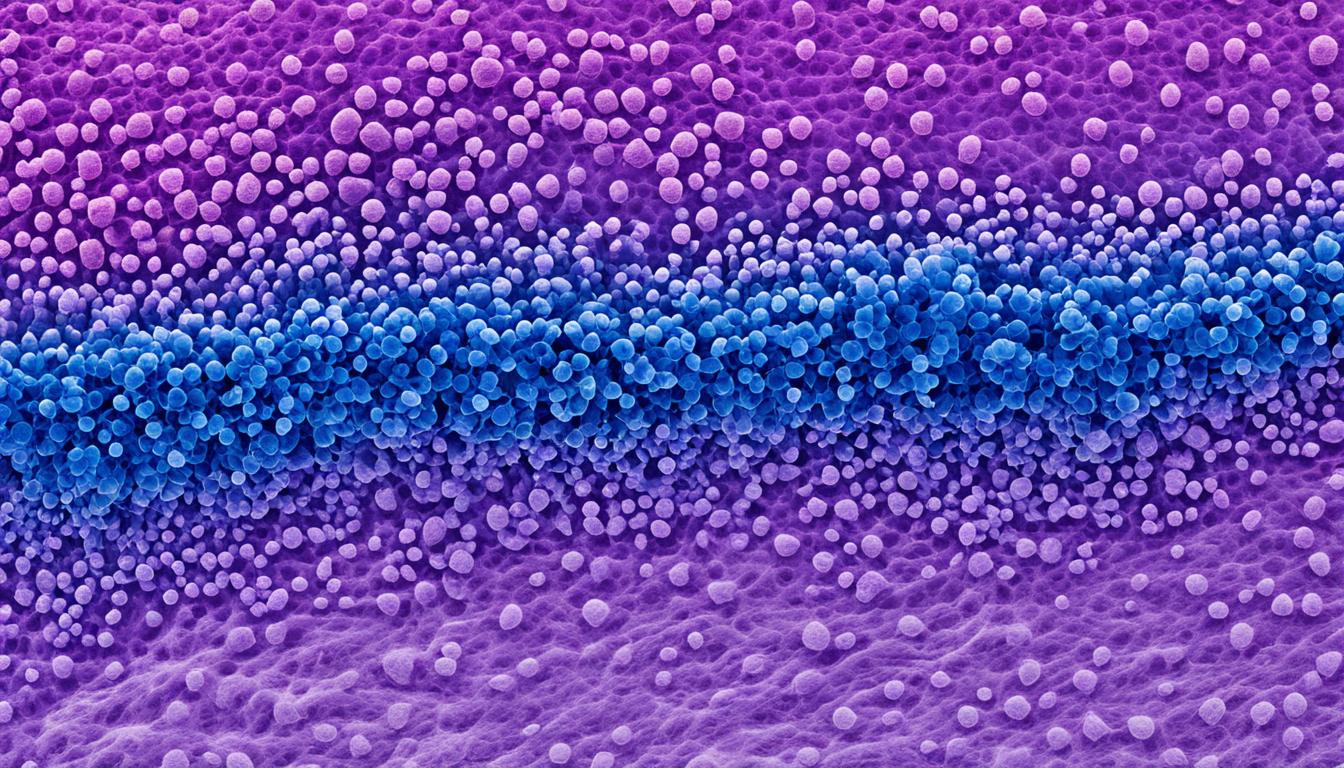Myxofibrosarcoma is a rare soft tissue cancer often found in older adults. It’s known for its unique tumors. These tumors show distinct patterns and are usually found in the limbs, trunk, or head and neck. About 60-70% of patients can survive for at least five years.
Patients with myxofibrosarcoma might notice a lump that does not hurt or some swelling. If the tumor presses on nearby tissues or nerves, it can cause pain. Doctors can find this cancer by using imaging tests like X-rays. A biopsy, taking a small piece of the tumor for testing, is another way to confirm it.
The main treatments are surgery to remove the tumor, radiation, and chemotherapy. But, doctors are also looking at new ways like stem cell therapy. Helping patients feel better and improve their life quality is a big part of care too.
Key Takeaways:
- Myxofibrosarcoma is a rare form of soft tissue cancer primarily affecting elderly patients.
- The disease is characterized by malignant tumors with myxoid stromata and distinct vascular patterns.
- Common symptoms include painless lumps or swelling and localized pain if nearby tissues or nerves are affected.
- Diagnosis involves imaging tests and biopsy to confirm the tumor type.
- Treatment options include surgery, radiation therapy, chemotherapy, stem cell therapy, and clinical trials.
- Supportive care is important for symptom management and improving patients’ quality of life.
Causes and Risk Factors of Myxofibrosarcoma
The exact cause of myxofibrosarcoma is a mystery. It usually happens without a clear family link. But, certain things can increase the risk of this rare cancer.
Treating past cancers with high radiation doses might raise later myxofibrosarcoma risk. Some genetic conditions can also make someone more likely to get sarcomas, like myxofibrosarcoma. Being around certain chemicals, like vinyl chloride, can possibly up the risk too. Yet, scientists need to do more research to know for sure about these risks.
| Possible Risk Factors for Myxofibrosarcoma |
|---|
| High doses of radiation therapy |
| Genetic conditions such as neurofibromatosis and tuberous sclerosis |
| Exposure to certain chemicals like vinyl chloride, dioxins, and phenoxyacetic herbicides |
| Infection with human herpesvirus 8 (Kaposi’s sarcoma) |
Kaposi’s sarcoma is caused by infection with human herpesvirus 8. But for myxofibrosarcoma, most cases have an unknown cause.
Diagnosis and Treatment of Myxofibrosarcoma
Diagnosing myxofibrosarcoma requires imaging tests and a biopsy. Doctors use X-rays, MRI, CT, or PET scans to see the tumor. This helps them check its size, where it is, and if it has spread. Then, a biopsy takes a tissue sample for detailed examination.
After diagnosing myxofibrosarcoma, treatment often includes different methods. Surgery is usually the first choice. It aims to completely remove the tumor and some normal tissue around it. This step is key to lower the tumor burden and stop its spread.
Doctors might also suggest radiation before or after surgery. This treatment uses high-energy radiation to kill any cancer cells left. It lowers the chances of the cancer coming back. Sometimes, radiation is the first treatment if the tumor cannot be removed by surgery.
Chemotherapy is a treatment which can be part of the plan for myxofibrosarcoma. It uses strong drugs to kill cancer cells or slow their growth. While not the main treatment, it may help for advanced cases, like when the cancer has reached the bone. Chemotherapy tackles leftover or spreading cancer cells.
For cases where common treatments don’t work, there are new options. Medicines like olaratumab (Lartruvo) or pazopanib (Votrient) can target the cancer’s growth. They offer hope for those with advanced or returning myxofibrosarcoma.
The approach to treating myxofibrosarcoma must fit the individual. Doctors consider the cancer’s stage and grade, its size, and how far it has spread. A sarcoma specialist’s careful review leads to a treatment plan that is just right. This plan aims to get the best results and enhance the patient’s life quality.
Prognosis and Future Directions for Myxofibrosarcoma
The outlook for myxofibrosarcoma varies based on several elements. These include the cancer’s stage and grade, and the tumor’s size and place. For people with local, regional, or distant myxofibrosarcoma, the 5-year survival rates differ. They are around 81%, 58%, and 16% sequentially. These rates are rough estimates, and outcomes could be different for each person.
Many are looking into new ways to treat myxofibrosarcoma. Stem cell therapy, for example, is a new approach that seems promising for sarcoma treatment. It uses special cells to help the body repair and grow new tissues. This could lead to better treatment results and higher chances of survival. Right now, trials are checking how well this therapy works for myxofibrosarcoma patients.
Additionally, caring for patients with myxofibrosarcoma is essential. This process helps improve their life quality. It includes supporting them with pain control and helping them emotionally. Having access to proper care is vital. It tackles the physical and emotional parts of dealing with myxofibrosarcoma.
Medical progress gives hope that myxofibrosarcoma treatment and outcomes will get better. Trials, new treatments, and focused therapies are on the horizon. Seeing a specialist in sarcoma care is key. They can create a treatment plan that suits the specific needs of each patient.

